

AP World History Long Essay Question Example 1
Have you written out your own response to the first of our AP World History Long Essay Questions ? Below you can review a sample answer and evaluate what earns this AP World History LEQ example a perfect score.
Evaluate the impact of the trans-Saharan trade routes on the exchange of goods, cultures, and ideas in Africa and the Islamic world during the period c. 1200–1750. Analyze the role of trade networks in shaping societies and economies during this era.
Sample Answer:
Thesis/Claim (1 point): The trans-Saharan trade routes played a pivotal role in facilitating the exchange of goods, cultures, and ideas between regions in Africa and the Islamic world during the period c. 1200–1750, leading to significant economic, cultural, and technological advancements. Contextualization (1 point): Before the emergence of the trans-Saharan trade routes, both Africa and the Islamic world experienced dynamic historical developments. In Africa, the Kingdom of Ghana flourished as a major trading empire, while in the Islamic world, the spread of Islam led to increased cultural diffusion and intellectual growth. These developments set the stage for the establishment of the trans-Saharan trade networks. Evidence (2 points): The trans-Saharan trade routes facilitated extensive exchanges between regions. One specific example of this exchange is the trade of gold from West Africa for salt and textiles from North Africa. The availability of gold in West Africa, particularly in the Mali Empire, spurred demand for North African goods. This trade not only enriched both regions economically but also led to cultural exchanges. Furthermore, the introduction of new crops such as sorghum and millet to West Africa from the Islamic world improved agricultural practices, leading to increased food production and population growth. Another significant development is the spread of Islam along these trade routes. As merchants and traders traveled across the Sahara, they also brought Islamic culture and religion with them. This resulted in the conversion of some African societies to Islam, creating a cultural and religious connection between regions. Additionally, the construction of notable centers of learning such as Timbuktu in Mali became hubs for intellectual exchange, where scholars from Africa and the Islamic world gathered to share knowledge. Analysis and Reasoning (2 points): The trans-Saharan trade routes not only connected regions economically but also fostered cultural and intellectual exchanges. This is evident in the adoption of Islamic practices and the establishment of centers of learning in West Africa. Furthermore, the trade in goods such as gold and salt played a vital role in the economic development of both regions. To achieve a more complex understanding, it’s essential to consider that while the trans-Saharan trade routes brought about positive exchanges, they also had challenges, such as the harsh desert environment and the impact on local communities. Nevertheless, the overall impact was largely beneficial, contributing to the growth and interconnectedness of African and Islamic societies. In conclusion, the trans-Saharan trade routes during the period c. 1200–1750 were instrumental in promoting economic, cultural, and intellectual exchanges between regions in Africa and the Islamic world. This interconnectedness resulted in mutual enrichment and the spread of Islamic culture and knowledge.
Total Points: 6
This essay provides a historically defensible thesis, relevant contextualization, specific evidence, and a well-structured analysis, earning a perfect score according to the AP World LEQ Rubric.
When you are finished with LEQ question 1, proceed to the next sample answers to review other strong essays or return to the main menu with the buttons below.
Find what you need to study
Writing the Long-Essay Question
november 15, 2019
Safiya Menk
Watch this live stream as Safiya discusses how to tackle the LEQ. She discusses how to break down the prompt and how to outline the LEQ, giving tips and tricks that will better your writing skills! If you struggle with writing/preparing an LEQ or don't understand how to do certain parts, then this stream will definitely help! If you also just wanna practice your LEQ skills, this stream is perfect. Safiya also tackles the LEQ prompt she wrote last year for the AP exam so you can get an idea of a student's perspective when it comes to the LEQ.

Stay Connected
© 2024 Fiveable Inc. All rights reserved.
AP® and SAT® are trademarks registered by the College Board, which is not affiliated with, and does not endorse this website.
US South Carolina
Recently viewed courses
Recently viewed.
Find Your Dream School
This site uses various technologies, as described in our Privacy Policy, for personalization, measuring website use/performance, and targeted advertising, which may include storing and sharing information about your site visit with third parties. By continuing to use this website you consent to our Privacy Policy and Terms of Use .
COVID-19 Update: To help students through this crisis, The Princeton Review will continue our "Enroll with Confidence" refund policies. For full details, please click here.
Enter your email to unlock an extra $25 off an SAT or ACT program!
By submitting my email address. i certify that i am 13 years of age or older, agree to recieve marketing email messages from the princeton review, and agree to terms of use., guide to the ap world history exam.

The AP ® World History: Modern exam covers historical developments from c 1200 to the present. It will test topics and skills discussed in your Advanced Placement World History: Modern course. If you score high enough, your AP score could earn you college credit !
Check out our AP World History Guide for what you need to know about the exam:
- AP World History: Modern Exam Overview
- AP World History: Modern Question Types
- AP World History: Modern Scoring
- How to Prepare
AP World History Exam Overview
The AP World History: Modern exam takes 3 hours and 15 minutes to complete and is composed of: a multiple-choice, short answer, and free response section.
AP World History Question Types
Multiple-choice.
AP World History: Modern multiple-choice questions are grouped into sets of usually 3-4 questions. They are based on primary or secondary sources, including excerpts from historical documents or writings, images, graphs, and maps. This section will test your ability to analyze and engage with the source materials while recalling what you already know about world history.
Short Answer
The AP World History: Modern short answer questions require you to respond to a secondary source for Question 1 and a primary source for Question 2, both focusing on historical developments between 1200 and 2001. Students will choose between two options (Questions 3 or 4) for the final required short-answer question, each one focusing on a different time periods of 1200 to 1750 and 1750 to 2001.
For all short answer questions, you’ll be asked to:
- Analyze the provided sources
- Analyze historical developments and processes described in the sources
- Put those historical developments and processes in context
- Make connections between those historical developments and processes
Document-Based Question (DBQ)
The AP World History: Modern DBQ presents a prompt and seven historical documents that are intended to show the complexity of a particular historical issue between the years 1450 and 2001. You will need to develop an argument that responds to the prompt and support that argument with evidence from both the documents and your own knowledge of world history. To earn the best score, you should incorporate outside knowledge and be able to relate the issues discussed in the documents to a larger theme, issue, or time period.
Long Essay Question
The AP World History: Modern Long Essay Question presents three questions and you have to choose one to answer. All questions will test the same skills but will focus on different historical periods (i.e., from c. 1200–1750, from c. 1450–1900, or from c. 1750–2001). Similar to the DBQ, you will need to develop and support an answer to the question you picked based on historical evidence to earn the best score possible.
For a comprehensive content review, check out our book, AP World History Prep
AP World History Review
The College Board is very detailed in what they require your AP teacher to cover in his or her AP World History course. They explain that you should be familiar with world history events from the following nine units that fall within four major time periods from 1200 to the present.
Read More: Review for the exam with our AP World History Cram Courses
AP scores are reported from 1 to 5. Here’s how students scored on AP World History exam in May 2020:
Source: College Board
How can I prepare?
AP classes are great, but for many students they’re not enough! For a thorough review of AP World History: Modern content and strategy, pick the AP prep option that works best for your goals and learning style. You can also check out our AP World History: Modern test prep book here .
- AP Exams

Explore Colleges For You
Connect with our featured colleges to find schools that both match your interests and are looking for students like you.

Career Quiz
Take our short quiz to learn which is the right career for you.

Get Started on Athletic Scholarships & Recruiting!
Join athletes who were discovered, recruited & often received scholarships after connecting with NCSA's 42,000 strong network of coaches.

Best 389 Colleges
165,000 students rate everything from their professors to their campus social scene.
SAT Prep Courses
1400+ course, act prep courses, free sat practice test & events, 1-800-2review, free digital sat prep try our self-paced plus program - for free, get a 14 day trial.

Free MCAT Practice Test
I already know my score.

MCAT Self-Paced 14-Day Free Trial

Enrollment Advisor
1-800-2REVIEW (800-273-8439) ext. 1
1-877-LEARN-30
Mon-Fri 9AM-10PM ET
Sat-Sun 9AM-8PM ET
Student Support
1-800-2REVIEW (800-273-8439) ext. 2
Mon-Fri 9AM-9PM ET
Sat-Sun 8:30AM-5PM ET
Partnerships
- Teach or Tutor for Us
College Readiness
International
Advertising
Affiliate/Other
- Enrollment Terms & Conditions
- Accessibility
- Cigna Medical Transparency in Coverage
Register Book
Local Offices: Mon-Fri 9AM-6PM
- SAT Subject Tests
Academic Subjects
- Social Studies
Find the Right College
- College Rankings
- College Advice
- Applying to College
- Financial Aid
School & District Partnerships
- Professional Development
- Advice Articles
- Private Tutoring
- Mobile Apps
- Local Offices
- International Offices
- Work for Us
- Affiliate Program
- Partner with Us
- Advertise with Us
- International Partnerships
- Our Guarantees
- Accessibility – Canada
Privacy Policy | CA Privacy Notice | Do Not Sell or Share My Personal Information | Your Opt-Out Rights | Terms of Use | Site Map
©2024 TPR Education IP Holdings, LLC. All Rights Reserved. The Princeton Review is not affiliated with Princeton University
TPR Education, LLC (doing business as “The Princeton Review”) is controlled by Primavera Holdings Limited, a firm owned by Chinese nationals with a principal place of business in Hong Kong, China.

Choose Your Test
Sat / act prep online guides and tips, the best ap world history study guide: 6 key tips.
Advanced Placement (AP)

Are you taking AP World History this year? Or considering taking it at some point in high school? Then you need to read this AP World History study guide. Instead of cramming every single name, date, and place into your head, learn how to study for the AP World History exam so that you can learn the major ideas and feel ready for test day. We'll also go over some key strategies you can use to help you prepare effectively.
The AP World History test is challenging — just 13.2% of test takers got a 5 in 2021 . But if you study correctly throughout the year, you could be one of the few students who aces this test. Below are six tips to follow in order to be well prepared for the AP World History exam. Read through each one, apply them to your test prep, and you'll be well on your way to maximizing your score!

Why You Should Study for the AP World History Test
Is it really that important to study for the AP World History test? Absolutely! But why?
Let's start by taking a look at the kinds of scores students usually get on the exam. The following chart shows what percentage of test takers received each possible AP score (1-5) on the AP World History test in 2022:
Source: The College Board
As you can see, roughly 49% of test takers scored a 2 or 3, about 35% scored a 4 or 5, and only 14% scored a 1. Since most test takers scored a 3 or lower on this test , it's safe to say that a lot of AP World History students are not scoring as well as they could be. (That said, the test underwent some big changes beginning in the 2019-2020 school year , so we can't make too many direct comparisons between this new version of the test and the old one. We will talk more about these changes in the next section.)
While a 3 is not a bad AP score by any means, some colleges such as Western Michigan University require at least a 4 in order to get credit for some exams. If the schools you're applying to want a 4 or higher, putting in ample study time for the test is a definite must.
In addition, if you're applying to highly selective schools , a 5 on the AP World History test (or any AP test, really) could act as a tipping point in your favor during the admissions process.
Finally, getting a low score on this test—i.e., a 1 or 2—might make colleges doubt your test-taking abilities or question your potential to succeed at their school. You don't want this to happen!
What's on the AP World History Exam?
Before we give you our six expert study tips for AP World History, let's briefly go over the structure and content of the test.
The AP World History exam consists of two sections: Section 1 and Section 2 . Each section also consists of two parts: Part A and Part B . Here's what you'll encounter on each part of each World History section:
And here is an overview of the types of tasks you'll be asked to perform:
- Analyze historical texts as well as historians' opinions and interpretations of history
- Assess historical documents and make an argument to support your assessment
- Write an essay concerning an issue in world history
Note that as of the 2019-2020 school year, AP World History is now much smaller in scope and is called AP World History: Modern (another course and exam called AP World History: Ancient is in the process of being made by the College Board).
These changes have been put in place mainly as a response to ongoing complaints that the original World History course was way too broad in scope, having previously covered thousands of years of human development. Hopefully, this will make the test somewhat easier!
Now that you understand exactly how the AP World History test is set up, let's take a look at our six expert study tips for it.
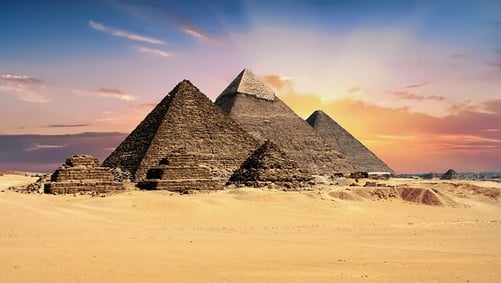
How to Study for AP World History: 6 Key Tips
Below are our top tips to help you get a great score on the AP World History test.
Tip 1: Don't Try to Memorize Everything
If you start your AP World History class with the expectation of memorizing the entirety of human history, think again .
Although AP World History tests a wide span of time, you aren't expected to learn every tiny detail along the way; rather, this course focuses on teaching major patterns, key cultural and political developments, and significant technological developments throughout history .
Starting in 2019-2020, the AP World History course and exam will be arranged in nine units , which cover a range of periods starting around 1200 CE and ending with the present:
For each period, you should know the major world powers and forces driving politics, economic development, and social/technological change; however, you don't have to have every detail memorized in order to do well on the test . Instead, focus on understanding big patterns and developments, and be able to explain them with a few key examples.
For instance, you don't necessarily need to know that in 1492 Columbus sailed the ocean blue; you also don't need to know the details of his voyages or the particulars of his brutality . Nevertheless, you should be able to explain why the European colonization of the Americas happened , as well as the economic effects it had on Europe, Africa, and the Americas, and how colonization impacted the lives of people on these three continents.
Knowing a few concrete examples is essential to succeeding on the short-answer section. Short-answer questions 1 and 2 will present you with a secondary source and a primary source, respectively, and then ask you to provide several examples or reasons for a broader theme or historical movement that relates to the information provided.
You'll have flexibility in what specific examples you choose , just so long as they are relevant. The short-answer section is three questions long and worth 20% of your total test score. You will have 40 minutes to complete it.
Concrete examples can also bolster your essays and improve your ability to break down multiple-choice questions on the topic; however, focus first on understanding the big picture before you try to memorize the nitty-gritty.
If you're coming from AP US History, this advice might seem odd. But unlike US History, which is more fine-grained, the AP World History exam writers do not expect you to know everything, as they test a much larger topic . AP US History is essentially a test of 400 years of history in one location, so it's fair to expect students to know many proper names and dates.
But for World History, that same level of detail isn't expected; this test takes place across 800 years all around the world. Instead, you should focus on understanding the general patterns of important topics through history . This won't only save you time but will also keep you sane as your textbook hurls literally hundreds of names, places, and dates at you throughout the year.
Speaking of your textbook ...
Tip 2: Keep Up With Your Reading!
When it comes to AP World History, you can't sleep through the class all year, skim a prep book in April, and then expect to get a perfect 5 on the test. You're learning a huge chunk of human history, after all! Trying to cram for this test late in the game is both stressful and inefficient because of the sheer volume of material you have to cover.

And all that reading would hurt your eyes.
Instead, keep up with your reading and do well in your World History class to ensure you're building a strong foundation of knowledge throughout the year. This way, when spring comes, you can focus on preparing for the exam itself and the topics it's likely to test, as opposed to frantically trying to learn almost a thousand years of human history in just two months.
If your teacher isn't already requiring you to do something like this, be sure to keep notes of your readings throughout the school year. This could be in the form of outlines, summaries, or anything else that's useful to you. Taking notes will help you process the readings and remember them better. Your notes will also be an invaluable study tool in the spring.
Finally, check the website of whatever textbook your class uses. Many textbook websites have extra features, such as chapter outlines and summaries , which can be excellent study resources for you throughout the year.
Tip 3: Read a Prep Book (or Two) in the Spring
Even if you keep up with AP World History throughout the year, you're probably going to be a bit hazy on topics you learned in September when you start studying for the test in March or April. This is why we recommend getting a prep book , which will provide a much broader overview of world history, focusing especially on topics tested on the exam. (Make sure it's an updated book for the new Modern focus of the AP World History course and exam!)
If you've been learning well throughout the school year, reading a prep book will trigger your background knowledge and help you review . Think of your prep book as your second, much quicker pass through world history.
And in case you're wondering—no, the prep book alone will not fill you in on the necessary depth of knowledge for the entire test. You can't replace reading your textbook throughout the year with reading a prep book in the spring. The AP World History multiple-choice section especially can ask some pretty specific questions, and you'd definitely have blind spots if all you did is read a prep book and not an actual textbook.
Furthermore, you wouldn't be able to explain examples in your essay in as much detail if you've only read a few paragraphs about major historical events.
Tip 4: Get Ready to Move at 1 MPQ (Minute per Question)
To prepare for the AP World History exam, knowing the material is just half the battle. You also need to know how to use your time effectively , especially on the multiple-choice section.
The multiple-choice section (Section 1, Part A) asks 55 questions in 55 minutes and is worth 40% of your total score. This gives you just one minute per question , so you'll have to move fast. And to be ready for this quick pace, practice is key.

Taking the AP World History exam without practicing first would be like jumping into a NASCAR race without a driver's license.
To practice pacing yourself, it's crucial that you get a prep book containing practice tests . Even if you've read your textbook diligently, taken notes, and reviewed the material, it's really important to practice actual multiple-choice sections so you can get used to the timing of the test.
Although there are a handful of stand-alone questions, most come in sets of three to four and ask you to look at a specific source, such as a graph, image, secondary source, or map. It's a good idea to skip and return to tough questions (as long as you keep an eye on the time!).
Your teacher should be giving you multiple-choice quizzes or tests throughout the year to help you prepare for the test. If your teacher isn't doing this, it will, unfortunately, be up to you to find multiple-choice practice questions from prep books and online resources. See our complete list of AP World History practice tests here (and remember to find updated materials for the new 2020 Modern exam).
You need to create your own multiple-choice strategy as you study , such as using the process of elimination, being ready to read and analyze pictures and charts, and being constantly aware of your time. I recommend wearing a watch when you practice so you can keep an eye on how long you spend on each question. Just make sure it's not a smart watch—unfortunately, those aren’t allowed!
Finally, make sure to answer every question on the exam . There are no penalties for incorrect answers, so you might as well guess on any questions you're not sure about or have no time for.
In short, make sure you practice AP World History multiple-choice questions so that when you sit down to take the exam, you'll feel confident and ready to move fast.

Tip 5: Practice Speed-Writing for the Free-Response Section
The AP World History exam has two essay questions that together account for 40% of your AP World History score . You'll get 60 minutes for the Document-Based Question, or DBQ, including a 15-minute reading period; the DBQ is worth 25% of your final grade. After, you will get 40 minutes for the Long Essay, which is worth 15% of your score.
For each essay, you need to be able to brainstorm quickly and write an essay that answers the prompt, is well organized, and has a cogent thesis . A thesis is a one-sentence summary of your main argument. For the sake of AP essays, it's best to put your thesis at the end of the introductory paragraph so the grader can find it quickly.
When organizing your essay, have each paragraph explain one part of the argument , with a topic sentence (basically, a mini-thesis) at the beginning of each paragraph that explains exactly what you're going to say.
For the DBQ, you'll need to bring most of the provided documents into your argument in addition to your background knowledge of the period being tested. For example, in a DBQ about the effects of Spanish Influenza during World War I, you'd need to demonstrate your knowledge of WWI as well as your ability to use the documents effectively in your argument. See our complete guide to writing a DBQ here .
For the Long Essay, it's up to you to provide specific historical examples and show your broad understanding of historical trends . (Again, this is why doing your reading is so important, since you'll have to provide and explain your own historical examples!)
Throughout the year, your teacher should be having you do writing assignments, including in-class essays, to teach you how to write good essays quickly. Since you'll be writing your essays by hand for the test, you should ideally be writing your practice essays by hand as well. If you struggle with writing by hand quickly, you can build up your writing fluency (that is, your ability to quickly translate thoughts to words) by writing additional practice essays on your own .
If you need to work on writing fluency, it's best to practice with easier writing topics . First, find a journal prompt to write about ( this website has hundreds ). Next, set a timer; between 10 and 15 minutes is best. Finally, write as much (and as fast!) as you can about the prompt, without making any big mistakes in spelling or grammar.
When time's up, count how many words you wrote . If you do this a few times a week, you'll build up your writing speed, and your word counts will continue to grow. Once you've built up this skill, it will be much easier to tackle the AP World History free-response section.
You can also practice on your own using old AP World History free-response questions . However, note that the test was revised for 2019-20 (now its focus is only on 1200-present) and 2016-17, so old questions will have old content and instructions .
In fact, there actually used to be three essays on the AP World History test—in addition to the DBQ, there was a "Change Over Time" essay and a "Comparison" essay. Now, there's just one long essay. Be sure to compare older questions with the most up-to-date examples from the most current AP Course and Exam Description .
Tip 6: Take Practice Exams and Set a Target Score
In the spring, aim to take at least one full practice exam —ideally in late March or early April—once you've learned most of the World History material. By a full practice exam, we mean the entire AP World History test. Time yourself and take it in one sitting, following official time restrictions.
Why should you do this? It will give you a chance to experience what it's like to take a full AP World History exam before you sit for the real thing. This helps you build stamina and perfect your timing. All the practice in the world won't help you if you run out of steam on your last essay question and can barely think.
Also, set a target score for each section. Good news: you don't need to be aiming for 100% on Section 1 and perfect scores on every essay in Section 2 in order to secure a 5 — the highest possible score . Far from it, actually!

The truth is that a high multiple-choice score (50/55) with average short-answer and free-response scores (say, 6/9 on short answer, 5/7 on the DBQ, and 4/6 on the long essay) can net you a score of 5 . Likewise, an average multiple-choice score (35/55) with high short-answer and free-response scores (say, 8/9 on short answer, 6/7 on the DBQ, and 5/6 on the long essay) can also net you a 5 .
Set realistic score targets based on your personal strengths. For example, a really good writing student might go the average multiple choice/strong essay route, while a stronger test taker might go the other way around. You could also be somewhere in-between.
In addition, don't be intimidated if your target score is a lot higher than your current scores . The whole point of practicing is to eventually meet your target!
Once you have a target score, practice, practice, practice ! Use old exams, the practice exams in (high-quality) prep books, and the free-response questions linked above. You can even ask your teacher for old AP World History tests and essay questions. (Just be aware of the key changes to the AP World History exam in recent years so that you can tweak practice questions as needed.)
The more you practice before the test, the more likely you are to meet—or even exceed!—your AP score goal.
Bottom Line: How to Prep for the AP World History Test
Although AP World History is a challenging test, if you follow all our advice in this AP World History study guide and prepare correctly throughout the school year, you can definitely pass the exam and might even be one of the few students who gets a 5 !
Just make sure to keep up with your reading, use an updated prep book in the spring, and practice a lot for the multiple-choice and free-response sections. With clear target scores for each section and plenty of practice under your belt, you will have the strongest chance of getting a 5 on test day !
What's Next?
How many AP classes should you take in total? Find out here in our expert guide .
How hard is AP World History compared with other AP tests? We've come up with a list of the hardest and easiest AP tests , as well as the average scores for every exam .
For more tips on doing well in all your classes, from AP to IB to honors, read this expert guide to getting a perfect 4.0 , written by PrepScholar founder Allen Cheng . Even if you're not going for perfection, you'll learn all the skills you need to work hard, act smart, and get better grades.
Also studying for the SAT/ACT? In a hurry? Learn how to cram for the ACT or SAT .

Halle Edwards graduated from Stanford University with honors. In high school, she earned 99th percentile ACT scores as well as 99th percentile scores on SAT subject tests. She also took nine AP classes, earning a perfect score of 5 on seven AP tests. As a graduate of a large public high school who tackled the college admission process largely on her own, she is passionate about helping high school students from different backgrounds get the knowledge they need to be successful in the college admissions process.
Ask a Question Below
Have any questions about this article or other topics? Ask below and we'll reply!
Improve With Our Famous Guides
- For All Students
The 5 Strategies You Must Be Using to Improve 160+ SAT Points
How to Get a Perfect 1600, by a Perfect Scorer
Series: How to Get 800 on Each SAT Section:
Score 800 on SAT Math
Score 800 on SAT Reading
Score 800 on SAT Writing
Series: How to Get to 600 on Each SAT Section:
Score 600 on SAT Math
Score 600 on SAT Reading
Score 600 on SAT Writing
Free Complete Official SAT Practice Tests
What SAT Target Score Should You Be Aiming For?
15 Strategies to Improve Your SAT Essay
The 5 Strategies You Must Be Using to Improve 4+ ACT Points
How to Get a Perfect 36 ACT, by a Perfect Scorer
Series: How to Get 36 on Each ACT Section:
36 on ACT English
36 on ACT Math
36 on ACT Reading
36 on ACT Science
Series: How to Get to 24 on Each ACT Section:
24 on ACT English
24 on ACT Math
24 on ACT Reading
24 on ACT Science
What ACT target score should you be aiming for?
ACT Vocabulary You Must Know
ACT Writing: 15 Tips to Raise Your Essay Score
How to Get Into Harvard and the Ivy League
How to Get a Perfect 4.0 GPA
How to Write an Amazing College Essay
What Exactly Are Colleges Looking For?
Is the ACT easier than the SAT? A Comprehensive Guide
Should you retake your SAT or ACT?
When should you take the SAT or ACT?
Stay Informed
Get the latest articles and test prep tips!
Looking for Graduate School Test Prep?
Check out our top-rated graduate blogs here:
GRE Online Prep Blog
GMAT Online Prep Blog
TOEFL Online Prep Blog
Holly R. "I am absolutely overjoyed and cannot thank you enough for helping me!”

AP® World History
The best ap® world history: modern review guide for 2024.
- The Albert Team
- Last Updated On: February 6, 2024
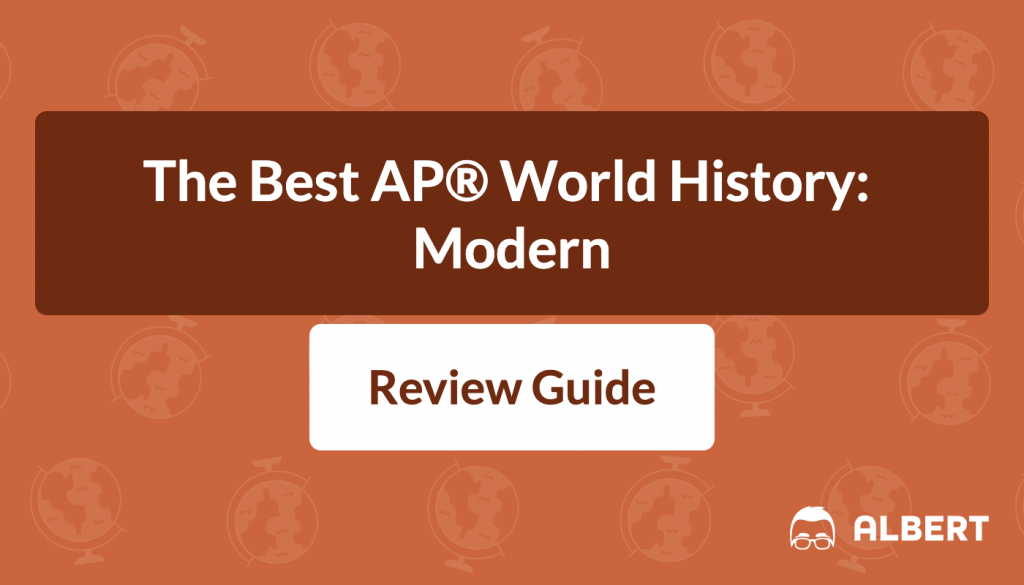
You’ve taken the class, you’ve put in the hours of studying for unit exams and completing the work assigned by your teacher, and now it’s crunch time for the 2024 AP® World History review exam!
Taking any AP® class can be difficult and stressful, but if you prepare and follow the guidelines and resources below, you will be even more armed with the knowledge and confidence to pass the exam.
This post includes information about the exam format, the topics covered, and study strategies for the AP® World History exam. Links to additional information and resources are also provided throughout.
What We Review
What’s the Format of the 2024 AP® World History: Modern Exam?
Students are given some choice over the short answer questions to answer (part 1B) as well as the specific long essay question to answer (part 2B).
You likely already know that AP® Modern World History covers the historical period from 1200 CE to the present, over eight hundred years!
The course is divided into 9 total units broken down as illustrated by the chart below. All topics are covered rather evenly by percentage, though units 3-6 compromise a slightly higher percentage of the exam.
Source: AP®World History: Modern CED
*Events, processes, and developments are not constrained by the given dates and may begin be fore or continue after the approximate dates assigned to each unit.
Return to the Table of Contents

How Long is the AP® World History: Modern Exam?
The AP® World exam begins with 55 stimulus-based multiple-choice questions. “Stimulus-Based” refers to the exam format in which groups of 3 to 4 questions are related to a single chart, graph, picture, or primary/secondary source excerpt. This format requires you to analyze the stimulus to answer the questions attached to it. The multiple-choice questions are 40% of the exam, and students have 55 minutes to complete the section.
After the multiple-choice section, there is a short answer section. You must answer the first two questions but have a choice between the third and fourth questions to answer three short-answer items. The short answer portion of the exam is 20% of the exam, and you have 40 minutes to write out responses for this section.
Following the short answer portion, the exam will have one hour to answer the Document-based Questions or the DBQs. You will write these extended response questions based on a set of primary and secondary sources. The DBQ portion makes up 25% of the total exam score.
The exam ends with the long essay portion, where you will respond to a question and craft an essay response. You will have 40 minutes to write this essay, and it makes up 15% of the exam score. Here is the link to the student page that breaks down the exam format even further if you are looking for more details.
What Topics are Covered on AP® World History: Modern Exam?
Albert provides numerous resources to help you prepare for the AP® World History: Modern Exam. Click here to access our practice questions for both multiple-choice and free response item types. There are also full-length practice tests so you can practice in a way that closely mimics the actual exam.
If you are looking for visual resources, those are covered as well. The chart below links to videos—both brief and detailed— explaining many of the topics covered in this exam. Most students learn best through multiple channels, so Albert provides both print and visual learning tools!
Units 1 and 2 make up between 16-20% of the exam, Units 3 through Unit 6 are the biggest percentage of the exam with a coverage range of 48-60%, and Units 7 through Unit 9 makeup 24-30% of the exam.
You can use this breakdown to guide exam preparations. For example, if you study for 100 minutes, you should spend between 48 and 60 minutes on Units 3-6.
Knowing the breakdown of the topics can be useful in being prepared for all portions of the exam, particularly those that require a written response. The Document Based Questions (DBQs) cover a wide year range and can be about any topic from Units 2 – 9. This might seem intimidating, but the documents can help provide context for your writing if you get stuck.
For the long essay question, you will be given three questions, and you will choose ONE to construct an argument-based response. You will be writing about either the period from c. 1200–1750, from c. 1450–1900, or from c. 1750–2001.
What Do AP® World History: Modern Exam Questions Look Like?
The multiple choice questions on the exam have a stimulus attached that you will use to answer the 2-4 questions connected to it. The stimulus could be a political cartoon, picture, map, or some other type of primary or secondary source. Here is a link to an example of a multiple-choice question you may see on the exam. This question is about Inca territorial expansion in the 1400s, and there is a map to use in answering the question.
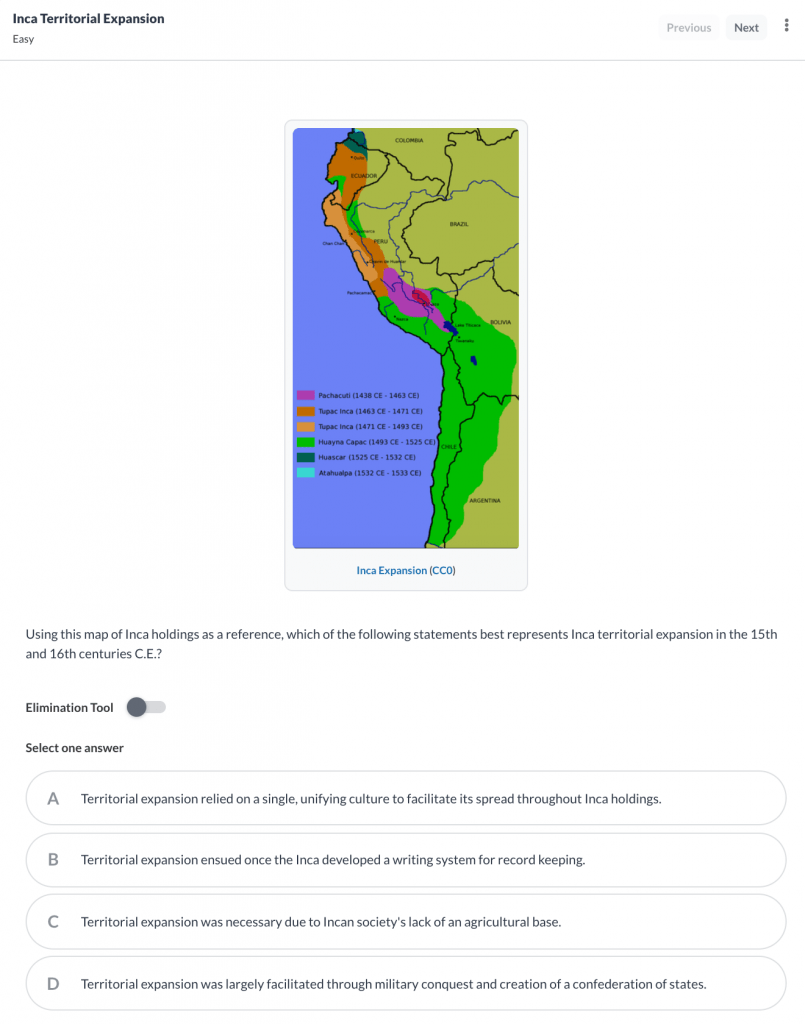
Older versions of the AP® exam did not always use stimuli in the multiple-choice sections, but the College Board decided that providing stimuli actually showcases a student’s higher-order and critical thinking skills. These skills of analysis, evaluation, and synthesis are required to answer these questions (as well as your overall knowledge of the topic).
The stimuli not only help to show how well you know the material but having the stimuli can really assist you in answering questions if you take the time to analyze what is provided.
Other sections of the exam, as described above, are the short answer, long essay question, and document based question.
Albert, on the upgraded platform, provides many document-based and long-essay questions. Here is the link to a list of all the AP® World FRQs that Albert has to offer .
Below you will find an example of one of the released free-response questions from the 2018 AP® World: Modern exam.
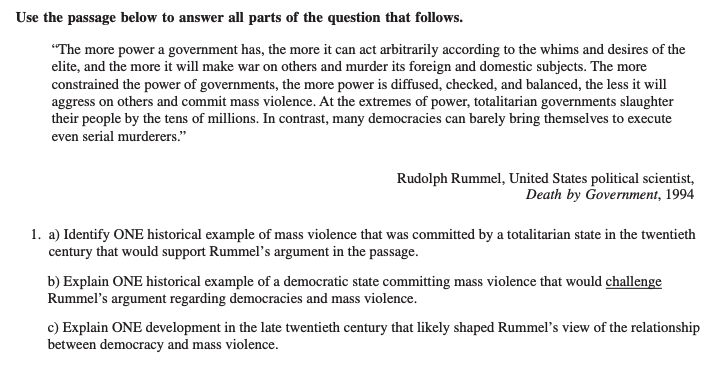
Source: College Board
Based on the scoring rubric that is provided by the College Board, there are recommended strategies to help you earn all three points for this free response question.
The first key to scoring well on this section of the exam is to truly make sure that you answer all three parts of the question. Make connections and use the stimulus to help you construct your response.
Use the ACE acronym when constructing your response:
- A: Answer the Question,
- C: Cite your supporting evidence, and
- E: explain how your evidence supports your response.
If you notice in the answer breakdown below, the answers don’t necessarily connect to each other. Each part of a Short Answer Question is worth one point and scored independently from the others.
The response from part A does not have to connect to your answer for part B. For example, you can discuss the Nazi Holocaust in part A, and then you can discuss the actions of British soldiers in Australia. These historical topics do not have connection to each other, but they answer part A and part B. To answer part C, you then make your claim about why the author may have made his claim about the difference between totalitarian governments and democratic governments.
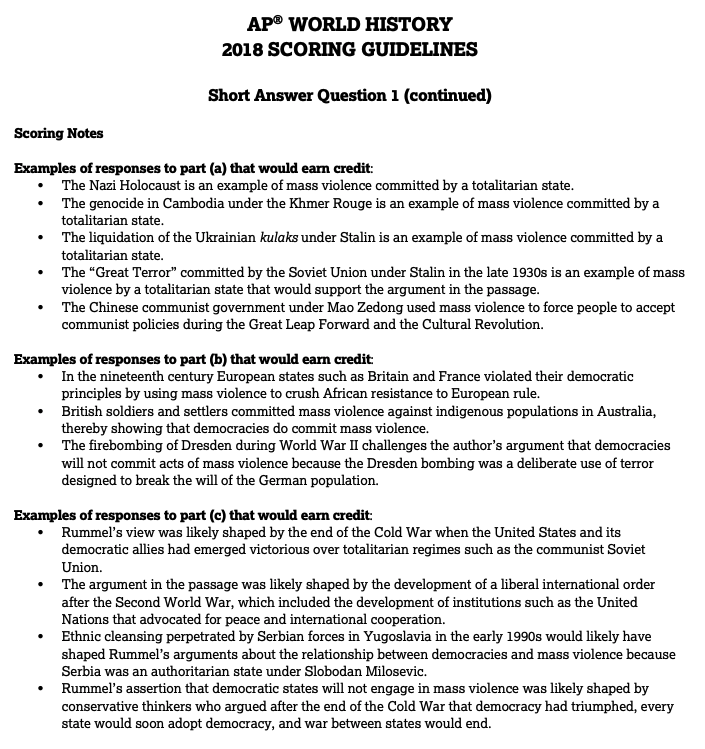
Source: AP® Central 2018 Released Free Response Questions
Focus on each individual part of the question and not necessarily the question as a single overarching unit. This can benefit you when writing a response because it guarantees that you answer what each part of the question is asking.
The multiple choice questions, as stated before, always have a stimuli attached. Below you will find an example of a question that you might see on the AP® World History exam. On the AP® exam, you would use this stimuli to answer 3-4 questions, but here is an example of one way you would use the map to answer a single question. This sample question is on the Albert website about the Industrial Revolution.
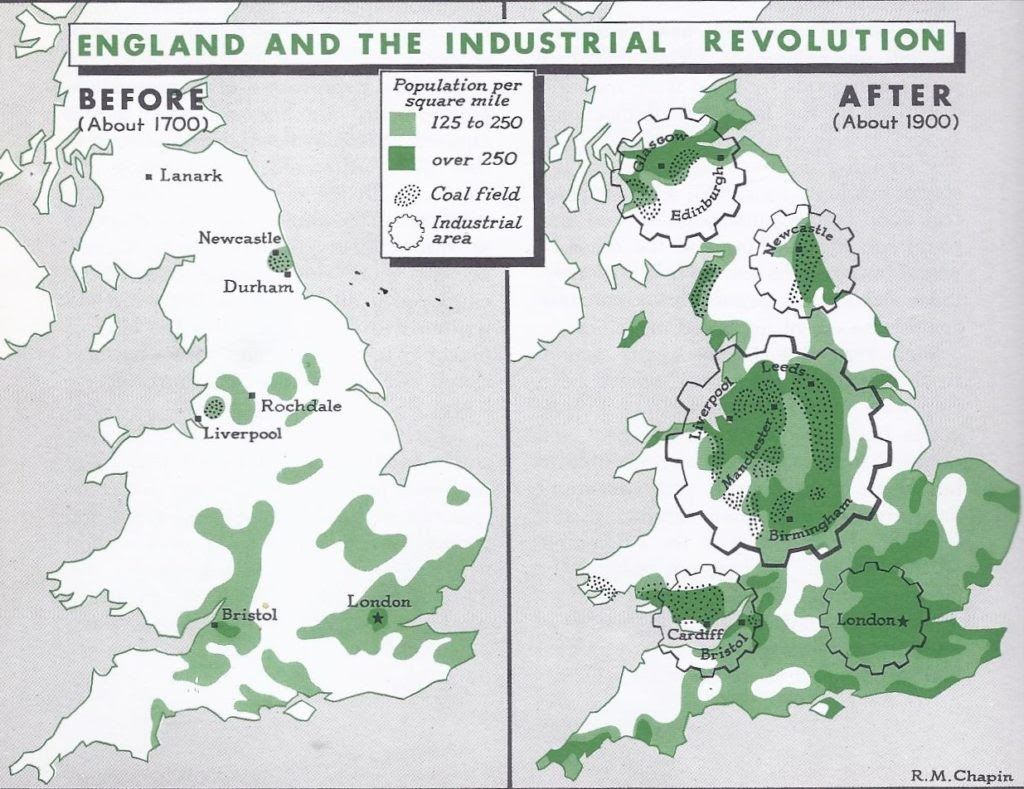
Question: What areas had the biggest population growth during the Industrial Revolution?
- Areas with considerable coal deposits
- Areas near the coastline
- Areas in northern England
- The areas of growth were not homogenous
Once you analyze the stimuli, which in this case is a map that shows the population difference due to the Industrial Revolution, the answer is (A).
The Industrial Revolution was driven by coal, so the population grew near coal deposits since coal was needed to run factories during the Industrial Revolution.
Students have one hour to answer the Document-Based Question, or the DBQ. These are extended response questions that you will write based on a set of primary and secondary sources. The DBQ portion makes up 25% of the total exam score. There are 7 possible points for the Document-Based Question (DBQ).
For a preview of what these prompts look like, here’s an example of a DBQ from a previous AP® World exam:
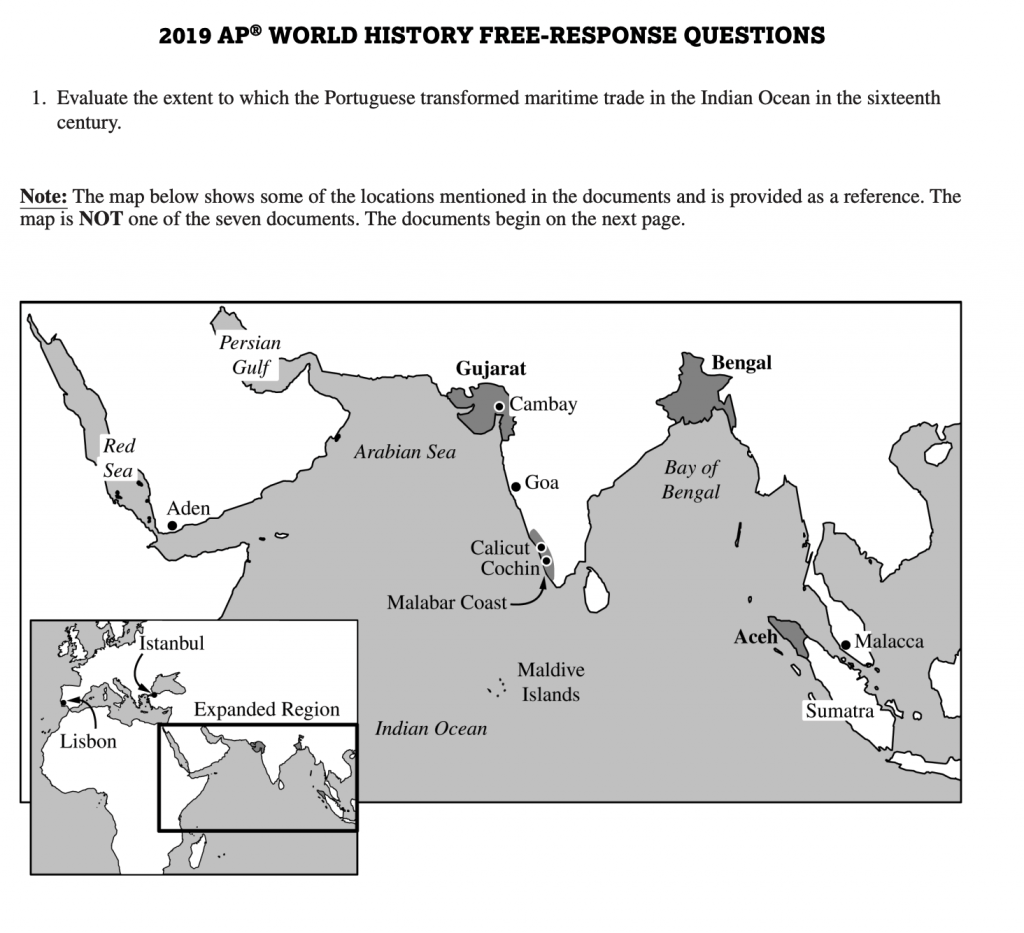
…and below are the accompanying documents from the 2019 DBQ. Note: click on each document below to see a larger view.
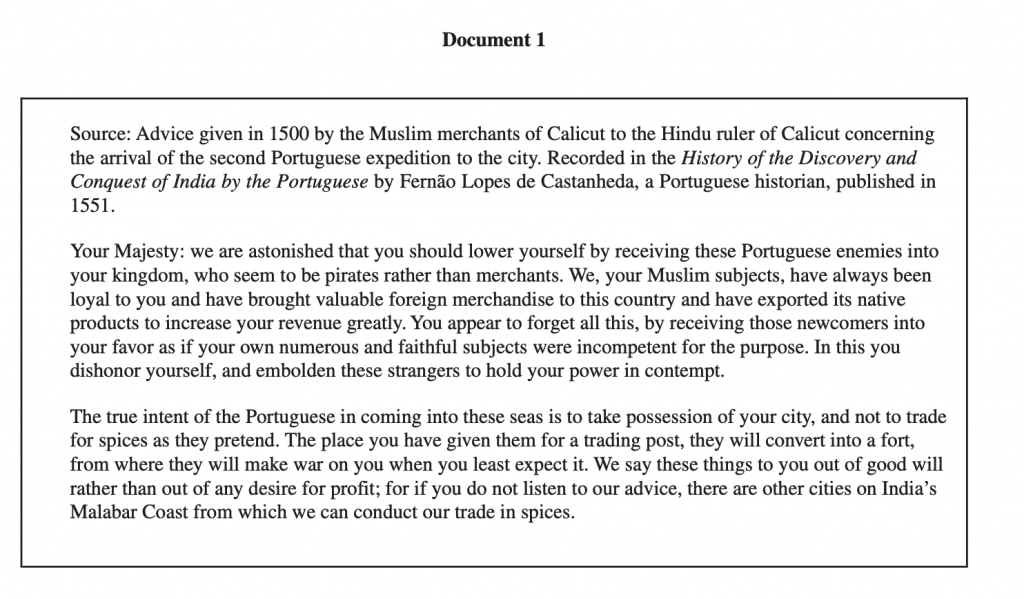
Additionally, the AP® World History: Modern exam includes a Long Essay Question (LEQ). Students are typically given 3 different LEQ prompts and are required to pick only one prompt to write their response.
Here are the examples of three prompts from the 2019 exam:
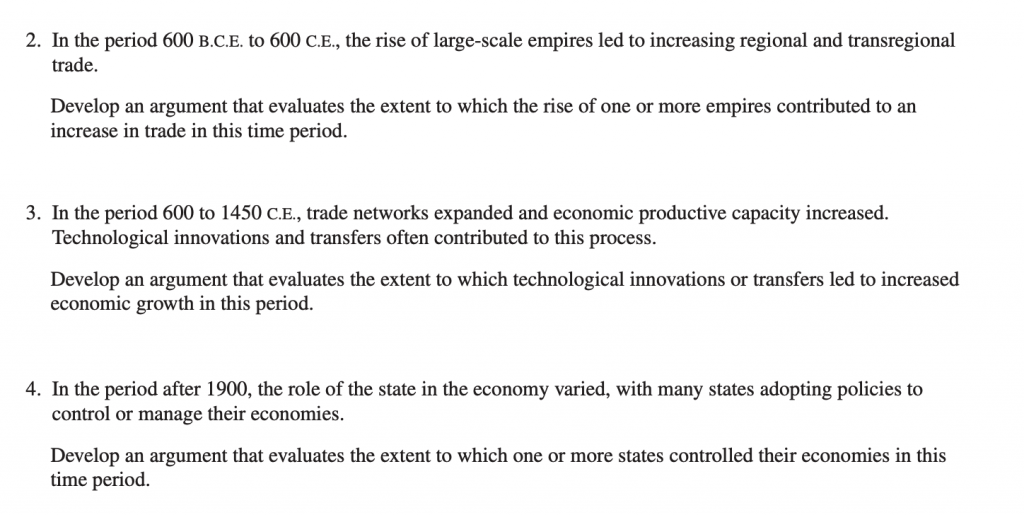
For more tips on how to answer these types of Free Response Questions on the AP® World exam, check out this article called “How to Answer AP® World History SAQs, DBQs, and LEQs” .
What Can You Bring to the AP® World History: Modern Exam?
Here is a list of items to bring on test day for in-person exams. To lessen the likelihood of stress on exam day, pack these items the night before so you are prepared.
DO bring these:
You should bring:
- No. 2 pencils for your multiple-choice answer sheet
- Pens with black or dark blue ink for completing areas on the exam booklet covers and for free-response questions in most exams
- If you don’t attend the school where you’re taking the exam, you will also need a current government-issued or school-issued photo ID. (Additional ID may be required by authorized test centers outside the United States.)
- Your College Board SSD Accommodations Letter if you are taking an exam with approved testing accommodations.
How to Study for AP® World History: Modern Exam: 5 Steps to Success
Everyone has a different study method and style, but these five steps will directly aid you in preparing for this exam.
1. Collect and organize all notes that you took during the year .
Put your notes in chronological order and then highlight topics that you struggled with during the year. Read through the notes, especially information from earlier in the year.
2. Either discuss the information with another person or try to teach the topics to someone else once you have organized the information.
For example, you may have a Socratic seminar with a study group from your class. You have likely participated in one during your class, but if you need help getting started here is a link to an outline for a Socratic seminar.
This tip can be very useful, but it is recommended that you practice a Socratic seminar or group discussion method of your choice in chunks of no more than one hour. However, you should hold discussions at least 5 times.
3. Practice how you would organize writing a DBQ, short answers, and long essay once you have collected your information and discussed the information with your peers.
Your teacher has probably given you many extended response questions throughout the year that mimic the exam, so use those to get started.
Use the organizational format that you like best and take time to master quickly mapping out an extended response.
Use your favorite writing outline web to practice sample questions that are provided on the AP® Central website or on the Albert website. If you don’t have a favorite writing outline web, here is one that you might find useful .
Limit your prewriting to 15 minutes as you are preparing for writing essays on a timed test. However, you can practice planning out responses for multiple writing prompts during each study period.
4. If you are still struggling after you have done the first three steps, use the resources provided to you on the AP® Central website.
Use the resources, such as the released questions from the past three years of the exam on a daily basis when studying.
Practice and study in small chunks throughout the weeks prior to the exam. Study for 20 minutes and then take a 10 minute break. Once you have completed about one hour of studying, you should take an extended break.
5. To fill in gaps, watch videos on a variety of historical topics covered on the exam— like those linked to earlier in this post.
After watching the video, you should write a 2-3 sentence summary about the video to refresh your memory about the topic.
Your summaries should not take long, so aim for 4 minutes maximum to jot down a quick summary of each video.
AP® World History: Modern Exam: 13 Must Know Study Tips
1. You have taken a whole year or semester of this course, so take a deep breath. You know this stuff.
Take time to do some deep breathing exercises that clear the mind and can assist with increasing focus. Here is a link to help you with deep breathing exercises.
2. Practice multiple choice questions from previous tests that you took during the year.
Your teacher wrote questions for your unit tests to mimic the questions you will see on this exam. Create a mistake log and cross-reference units to identify which units you need to prioritize most. Look at your old tests and find which types of questions you struggled with the most to guide what to focus on while studying.
3. Construct a free response question from one of the released questions from the College Board or from Albert.
Here are all the practice questions released on the College Board ‘s website. Also here is the link to resources on the Albert website.
Write a free response long essay once a week for about one month prior to the exam so you are able to write on a variety of topics and get comfortable with the allotted time to do so.
4. If you are a visual learner, watch the videos that are linked above for each unit .
Watching and hearing the information again may help on test day! Once you have watched the videos, summarize the top three takeaways from each video so you have a summary page to read over on test day.
5. If you are an auditory learner, listen to historical podcasts on Spotify or listen to YouTube videos without watching.
Here is a link to a few historical podcasts to prepare you for the exam. After you listen, summarize the top 3 takeaways from each podcast so you have a summary page to read over on test day.
6. If you are a tactile learner, you can rewrite or type your notes because the repetition will help you remember the information.
This may sound pretty old school, but repetition is beneficial to help people remember information.
7. Time yourself on the multiple choice questions .
You will have one minute per question because there are 55 questions, and you have 55 minutes to complete the section. Learn to not dwell on questions and come back at the end if you need to. Do not spend more than 1.5 minutes on a question, even if you are stuck.
8. Construct DBQ responses (document based questions) .
You may find these daunting since you have to use the source documents in your writing. Albert provides a variety of DBQs that you can write during your study period prior to the exam.
Just like the free response questions, write no more than once a week but attempt to write a total of 4 DBQs. Just a reminder, you have 60 minutes during the exam to construct a DBQ, so time yourself during your writing.
Many students struggle with incorporating the documents into their writing. Attempt to use all the document s to support your argument.
Here is a link to a comprehensive post about the aspects of the FRQ’s from Albert.
9. Practice your free response questions and learn about key turning points.
You will not have documents to help organize your response in this portion of the exam, so make sure you have a general understanding of key themes through world history.
If you understand the units and can place historical events into these time periods, you have context for all your FRQ’s.
10. Practice your short answers.
These can really help your overall total score, so make sure you take them seriously. But also make sure you don’t ramble. Answer the question asked thoroughly, but do not drag out the response. Here is an example short answer question and response from Albert.
11. Try and study with a classmate .
Saying the information out loud and “teaching” others has shown to really help students learn and recall information.
Use the socratic seminar outline that is provided in the previous section for maximum impact.
12. Trust that your teacher prepared you well! Use your notes and resources that were given to you throughout the class.
Highlight topics that you struggled with during the year and focus a larger portion (about 25%) of your studying efforts to learn that information.
13. Albert and AP® Central are great resources with many details if you have further questions about the structure of the exam.
Take one of Albert’s full-length practice tests, then review which topics and units you struggled with most. From there, isolate your practice to focus on these weaknesses so that you can make the most of your limited study time. After you’ve built up your confidence in these areas, take another full-length practice exam; repeat this process until you feel ready .
AP® World History: Modern Exam: 5 Test Day Tips to Remember
Here are some test day study tips to help get you prepared to pass the AP® World History: Modern Exam:
1. Review information that you may have struggled with over the past couple weeks.
Do not spend more than fifteen minutes reviewing last minute information.
Read the summary sheets you collected from the videos and podcasts as well as your notes from your Socratic seminar.
2. Make sure you bring the bag that you packed the night before with all the items you need to take the exam .
Review the bring and do not bring list from earlier in the post!
3. On your way to the exam, start talking to yourself. It may be a little funny, but saying things out loud is proven to help you remember the information.
According to psychologists , once you get your ears involved in the learning process, more senses are engaged with your learning.
4. Stay focused on what you are there to accomplish.
Keep your confidence level up but remain calm. Use the deep breathing exercises that were provided in the 13 Must Know Study Tips section .
Know that you are prepared to pass the AP® World History: Modern Exam.
5. Take your time on your exam but keep yourself organized, especially on the writing sections.
Remember that you have 55 minutes for 55 multiple choice questions, so move quickly and do not dwell on questions for too long.
For the free response questions, you have forty minutes to produce three short answer questions., You have sixty minutes for the DBQ, and you have forty minutes for the long essay. Plan on taking about 5-8 minutes on planning before writing each free response question.
AP® World History: Modern Exam Review Notes and Practice Test Resources
Now that you have read through this “How to Pass” guide, here are some great additional resources to help get you more prepared for the AP® World History: Modern exam.
Two Additional AP® World History: Modern Resources:
Freemanpedia.

This website provides resources for all topics and units for AP® World: Modern.
Use this site if: you need more in-depth resources about the entire course. This site provides a variety of graphic organizers about key ideas for each unit.
Do not use this site if: you do not like graphic organizers. There are a ton of them on each page for each unit.
Heimler’s History: Youtube Channel:
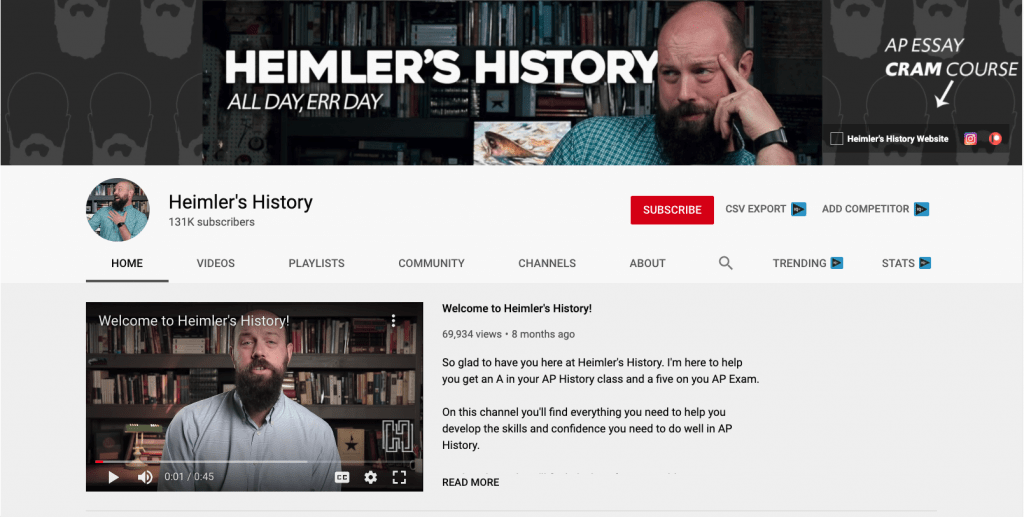
On this Youtube channel, you will find a collection of videos that cover the entire curriculum for AP® World History.
Use this site if: you are a visual learner and need a quick overview of each topic that you learned during the course.
Do not use this site if: you are not a visual learner or you need more in- depth information about a certain topic.
Summary: The Best 2024 AP® World History: Modern Exam Review Guide
You have the information, you have the skills, and you have the motivation to get ready to pass the AP® Modern World History exam. In this post there are a variety of resources to benefit a multitude of learners.
There are videos to help jog your memory about the topics covered in the exam. There are links to practice questions and more information if you have any further questions about the AP® World History: Modern Exam.
This How to Pass AP® World History: Modern Review Guide will be a great starting and endpoint on your journey to get prepared. If you need any other resources, check the Albert website as there are many other resources available! Good luck and stay positive…you got this!
Interested in a school license?
Popular posts.

AP® Score Calculators
Simulate how different MCQ and FRQ scores translate into AP® scores

AP® Review Guides
The ultimate review guides for AP® subjects to help you plan and structure your prep.

Core Subject Review Guides
Review the most important topics in Physics and Algebra 1 .

SAT® Score Calculator
See how scores on each section impacts your overall SAT® score

ACT® Score Calculator
See how scores on each section impacts your overall ACT® score

Grammar Review Hub
Comprehensive review of grammar skills

AP® Posters
Download updated posters summarizing the main topics and structure for each AP® exam.

IMAGES
VIDEO
COMMENTS
Rubrics Updated for 2023-24. We've updated the AP World History: Modern document-based question (DBQ) and long essay question (LEQ) rubrics for the 2023-24 school year. This change only affects the DBQ and LEQ scoring, with no change to the course or the exam: the exam format, course framework, and skills assessed on the exam all remain ...
The second part of Section II of the AP World History exam contains three long essay questions—you must respond to one. The long essay question assesses your ability to apply knowledge of history in a complex, analytical manner. In other words, you are expected to treat history and historical questions as a historian would.
Step 1: Analyze the Prompt. On the actual exam, you will read three questions and determine which you can answer most confidently. For this sample question, note that you will be evaluating how changes in the spread of ideas impacted societies. The words "changes," "impacted," and "the extent" indicate that this prompt is testing ...
1750-2001. 1890-2001. 1815-2001. Writing time on the AP Exam includes both the Document Based Question (DBQ) and the (LEQ), but it is suggested that you spend 40 minutes completing the LEQ. You will need to plan and write your essay in that time. A good breakdown would be 5 min. (planning) + 35 min. (writing) = 40 min.
Below you can review a sample answer and evaluate what earns this AP World History LEQ example a perfect score. Evaluate the impact of the trans-Saharan trade routes on the exchange of goods, cultures, and ideas in Africa and the Islamic world during the period c. 1200-1750. Analyze the role of trade networks in shaping societies and ...
Summary: What to Know About the AP World History Exam. The AP World History exam is a three-hour and 15-minute test that consists of 55 multiple-choice questions, three short answers, one DBQ, and one essay. Questions address six major historical themes and nine units, with periods stretching back to the year 1200 CE.
First, download the AP World History Cheatsheet PDF - a single sheet that covers everything you need to know at a high level. Take note of your strengths and weaknesses! We've put together the study plan found below to help you study between now and May. This will cover all of the units and essay types to prepare you for your exam.
🌍 Exam Skills study guides written by former AP World students to review Exam Skills with detailed explanations and practice questions. ... Exam Skills. Writing the Long-Essay Question. Writing the Long-Essay Question. november 15, 2019. Safiya Menk. ... AP World History: Modern. Exam Skills. Writing the Long-Essay Question.
The AP World History: Modern Long Essay Question presents three questions and you have to choose one to answer. All questions will test the same skills but will focus on different historical periods (i.e., from c. 1200-1750, from c. 1450-1900, or from c. 1750-2001). Similar to the DBQ, you will need to develop and support an answer to the ...
The long essay question on the AP World History exam assesses your ability to apply knowledge of history in a complex, analytical manner. In other words, you are expected to treat history and historical questions as a historian would. This process is called historiography—the skills and strategies historians use to analyze and interpret ...
The AP World History exam includes topics on historical events from c. 1200 - the present. Based on the college board's curriculum, the course is categorized into skills, themes, and units. ... 1 Document-based Question : 60 minutes: 25%: Part B: 1 Long-Essay Question: 40 minutes: 15%: Let us explore these question types. Section I, Part A ...
The final AP® World History exam question is the long essay question. You will have 40 minutes to answer this question. The essay question requires you to analyze a significant world history event and argue a point that is supported by the evidence. For this question, you can choose from three time periods: 1200-1750, 1450-1900, or 1750-2001.
The AP World History exam has two essay questions that together account for 40% of your AP World History score. You'll get 60 minutes for the Document-Based Question, or DBQ, including a 15-minute reading period; the DBQ is worth 25% of your final grade. After, you will get 40 minutes for the Long Essay, which is worth 15% of your score.
40 minutes. 15%. Students are given some choice over the short answer questions to answer (part 1B) as well as the specific long essay question to answer (part 2B). You likely already know that AP® Modern World History covers the historical period from 1200 CE to the present, over eight hundred years!
Long Essay Question. For this section, you will be shown how to write a Continuity and Change Over Time Long Essay for the AP World History Exam. Students are asked to use one historical reasoning skill—causation; comparison; or continuity and change over time—to develop an argument in response to the prompt.
Exam essays should be considered first drafts and thus may contain grammatical errors. Those errors will not be counted against a student unless they obscure the successful demonstration of the content knowledge, skills, and practices described below ... AP World History: Modern Long Essay Question 3
AP Credit Policy Search Your AP scores could earn you college credit or advanced placement (meaning you could skip certain courses in college). Use this tool to find colleges that offer credit or placement for AP scores.
The AP World History Exam is 3 hours and 15 minutes long and includes both a 95-minute multiple-choice and short-answer section (Section I) and a 100-minute free-response section ... Part B: Long essay question 1 question: periods 3-6: 1 question, chosen from three options on the same theme: w: periods 1-2 w periods 3-4: w: periods 5-6
AP African American Studies Exam Pilot: For the 2024 AP Exam administration, only schools that are participating in the 2023-24 AP African American Studies Exam Pilot can order and administer the exam. AP Seminar end-of-course exams are only available to students taking AP Seminar at a school participating in the AP Capstone Diploma Program ...